Separation Control on a Bridge Box Girder Using a Bypass Passive Jet Flow
Abstract
:1. Introduction
2. Experiment Setup and Model Configuration
2.1. Model Configuration
2.2. Experimental Setup for Aerodynamic Force Measurements
2.3. Experimental Setup for Pressure Measurements
2.4. Experimental Setup for PIV Measurements
3. Results and Discussion
3.1. Analysis of Aerodynamic Coefficients
3.2. Analysis of Surface Pressure Distributions
3.3. Analysis of PIV Experimental Results
3.4. Discussion of the Results
4. Conclusions
Acknowledgments
Author Contributions
Conflicts of Interest
References
- Ehsan, F.; Scanlan, R.H. Vortex-induced vibrations of flexible bridges. J. Eng. Mech. 1990, 116, 1392–1411. [Google Scholar] [CrossRef]
- Larsen, A.; Walther, J.H. Aeroelastic analysis of bridge girder sections based on discrete vortex simulations. J. Wind Eng. Ind. Aerodyn. 1997, 67, 253–265. [Google Scholar] [CrossRef]
- Larsen, A. Advances in aeroelastic analyses of suspension and cable-stayed bridges. J. Wind Eng. Ind. Aerodyn. 1998, 74–76, 73–90. [Google Scholar] [CrossRef]
- Taylor, Z.J.; Gurka, R.; Kopp, G.A. Geometric effects on shedding frequency for bridge sections. In Proceedings of the 11th Americas conference on wind engineering, San Juan, Puerto Rico, 22–26 June 2009. [Google Scholar]
- Larsen, A.; Esdahl, S.; Andersen, J.E.; Vejrum, T. Storebaelt suspension bridge-vortex shedding excitation and mitigation by guide vanes. J. Wind Eng. Ind. Aerodyn. 2000, 88, 283–296. [Google Scholar] [CrossRef]
- Fujino, Y.; Yoshitaka, Y. Wind-induced vibration and control of Trans-Tokyo Bay Crossing Bridge. J. Struct. Eng. 2002, 128, 1012–1025. [Google Scholar] [CrossRef]
- Li, H.; Laima, S.J.; Ou, J.P.; Zhao, X.F.; Zhou, W.S.; Yu, Y.; Li, N.; Liu, Z.Q. Investigation of vortex-induced vibration of a suspension bridge with two separated steel box girders based on field measurements. Eng. Struct. 2011, 33, 1894–1907. [Google Scholar] [CrossRef]
- Larsen, A.; Svensson, E.; Andersen, H. Design aspects of tuned mass dampers for the Great Belt East Bridge approach spans. J. Wind Eng. Ind. Aerodyn. 1995, 54–55, 413–426. [Google Scholar] [CrossRef]
- Andersen, L.; Birch, N.W.; Hansen, A.H.; Skibelund, J.O. Response analysis of tuned mass dampers to structures exposed to vortex loading of Simiu-Scanlan Type. J. Sound. Vib. 2001, 239, 217–231. [Google Scholar] [CrossRef]
- Battista, R.C.; Pfeil, M.S. Reduction of vortex-induced oscillations of Rio–Niterói Bridge by dynamic control devices. J. Wind Eng. Ind. Aerodyn. 2000, 84, 273–288. [Google Scholar] [CrossRef]
- Zhang, H.F.; Xin, D.B.; Ou, J.P. Wake control of vortex shedding based on spanwise suction of a bridge section model using Delayed Detached Eddy Simulation. J. Wind Eng. Ind. Aerodyn. 2016, 155, 100–114. [Google Scholar] [CrossRef]
- Bakis, K.N.; Massaro, M.; Williams, M.S.; Limebeer, D.J.N. Aeroelastic control of long-span suspension bridges with controllable winglets. Struct. Control Health Monit. 2016, 23, 1417–1441. [Google Scholar] [CrossRef]
- Wang, Q.; Liao, H.L.; Li, M.S.; Ma, C. Influence of aerodynamic configuration of a streamline box girder on bridge flutter and vortex-induced vibration. J. Mod. Transp. 2011, 19, 261–267. [Google Scholar] [CrossRef]
- Bruno, L.; Mancini, G. Importance of Deck Details in Bridge Aerodynamics. Struct. Eng. Int. 2002, 12, 289–294. [Google Scholar] [CrossRef]
- Zhou, R.; Yang, Y.X.; Ge, Y.J.; Priyan, M.; Damith, M. Practical countermeasures for the aerodynamic performance of long-span cable-stayed bridges with open decks. Wind Struct. 2015, 21, 223–239. [Google Scholar] [CrossRef]
- El-Gammal, M.; Hangan, H.; King, P. Control of vortex shedding-induced effects in a sectional bridge model by spanwise perturbation method. J. Wind Eng. Ind. Aerodyn. 2007, 95, 663–678. [Google Scholar] [CrossRef]
- Baek, H.; Karniadakis, G.E. Suppressing vortex-induced vibrations via passive means. J. Fluid Struct. 2009, 25, 848–866. [Google Scholar] [CrossRef]
- Chen, W.L.; Gao, D.L.; Yuan, W.Y.; Li, H.; Hu, H. Passive jet control of flow around a circular cylinder. Exp. Fluids 2015, 56, 201. [Google Scholar] [CrossRef]
- Larose, G.L.; D’Auteuil, A. On the Reynolds number sensitivity of the aerodynamics of bluff bodies with sharp edges. J. Wind Eng. Ind. Aerodyn. 2006, 94, 365–376. [Google Scholar] [CrossRef]
- Larsen, A.; Savage, M.; Lafrenière, A.; Hui, M.C.H.; Lansen, S.V. Investigation of vortex response of a twin box bridge section at high and low Reynolds numbers. J. Wind Eng. Ind. Aerodyn. 2008, 96, 934–944. [Google Scholar] [CrossRef]
- Li, H.; Laima, S.J.; Jing, H. Reynolds number effects on aerodynamic characteristics and vortex-induced vibration of a twin-box girder. J. Fluid Struct. 2014, 50, 358–375. [Google Scholar] [CrossRef]
- Irwin, H.P.A.H.; Cooper, K.R.; Girard, R. Correction of distortion effects caused by tubing systems in measurements of fluctuating pressures. J. Wind Eng. Ind. Aerodyn. 1979, 5, 93–107. [Google Scholar] [CrossRef]
- Barlow, B.; Rae, H.; Pope, A. Low-Speed Wind Tunnel Testing, 3rd ed.; Wiley: New York, NY, USA, 1999; pp. 330–375. [Google Scholar]
- Hu, H.; Koochesfahani, M.M. Thermal Effects on the Wake of a Heated Circular Cylinder Operating in Mixed Convection Regime. J. Fluid Mech. 2011, 685, 235–270. [Google Scholar] [CrossRef]
- Liu, Y.; Chen, W.L.; Bond, L.; Hu, H. An Experimental Study on the Characteristics of Wind-driven Surface Water Film Flows by Using a Multi-Transducer Ultrasonic Pulse-Echo Technique. Phys. Fluids 2017, 29, 012102. [Google Scholar] [CrossRef]
- Tian, W.; Ozbay, A.; Hu, H. Effects of Incoming Surface Wind Conditions on the Wake Characteristics and Dynamic Wind Loads Acting on a Wind Turbine Model. Phys. Fluids 2014, 26, 125108. [Google Scholar] [CrossRef]
- Yuan, W.Y.; Laima, S.J.; Chen, W.L.; Li, H.; Hu, H. Investigation on the vortex-and-wake-induced vbiration of a separated-box bridge girder. J. Fluid Struct. 2017, 70, 145–161. [Google Scholar] [CrossRef]
- Samimy, M.; Lele, S.K. Motion of particles with inertia in a compressible free shear layer. Phys. Fluids 1991, 3, 1915–1923. [Google Scholar] [CrossRef]
- Chen, W.L.; Li, H.; Hu, H. An experimental study on a suction flow control method to reduce the unsteadiness of the wind loads acting on a circular cylinder. Exp. Fluids 2014, 55, 1707. [Google Scholar] [CrossRef]
- Frandsen, J.B. Comparison of numerical prediction and full-scale measurements of vortex induced oscillations. In Proceedings of the 4th International Colloquium on Bluff Body Aerodynamics and Applications, Ruhu-University of Bochum, Bochum, Germany, 11–14 September 2000. [Google Scholar]
- Gao, D.L.; Chen, W.L.; Li, H.; Hu, H. Flow around a circular cylinder with slit. Exp. Therm. Fluid Sci. 2017, 82, 287–301. [Google Scholar] [CrossRef]
- Zhou, J.; Adrian, R.J.; Balachandar, S.; Kendall, T.M. Mechanisms for generating coherent packets of hairpin vortices in channel flow. J. Fluid Mech. 1999, 387, 353–396. [Google Scholar] [CrossRef]
- Chen, W.L.; Li, H.; Hu, H. An experimental study on the unsteady vortices and turbulent flow structures around twin-box-girder bridge deck models with different gap ratios. J. Wind Eng. Ind. Aerodyn. 2014, 132, 27–36. [Google Scholar] [CrossRef]
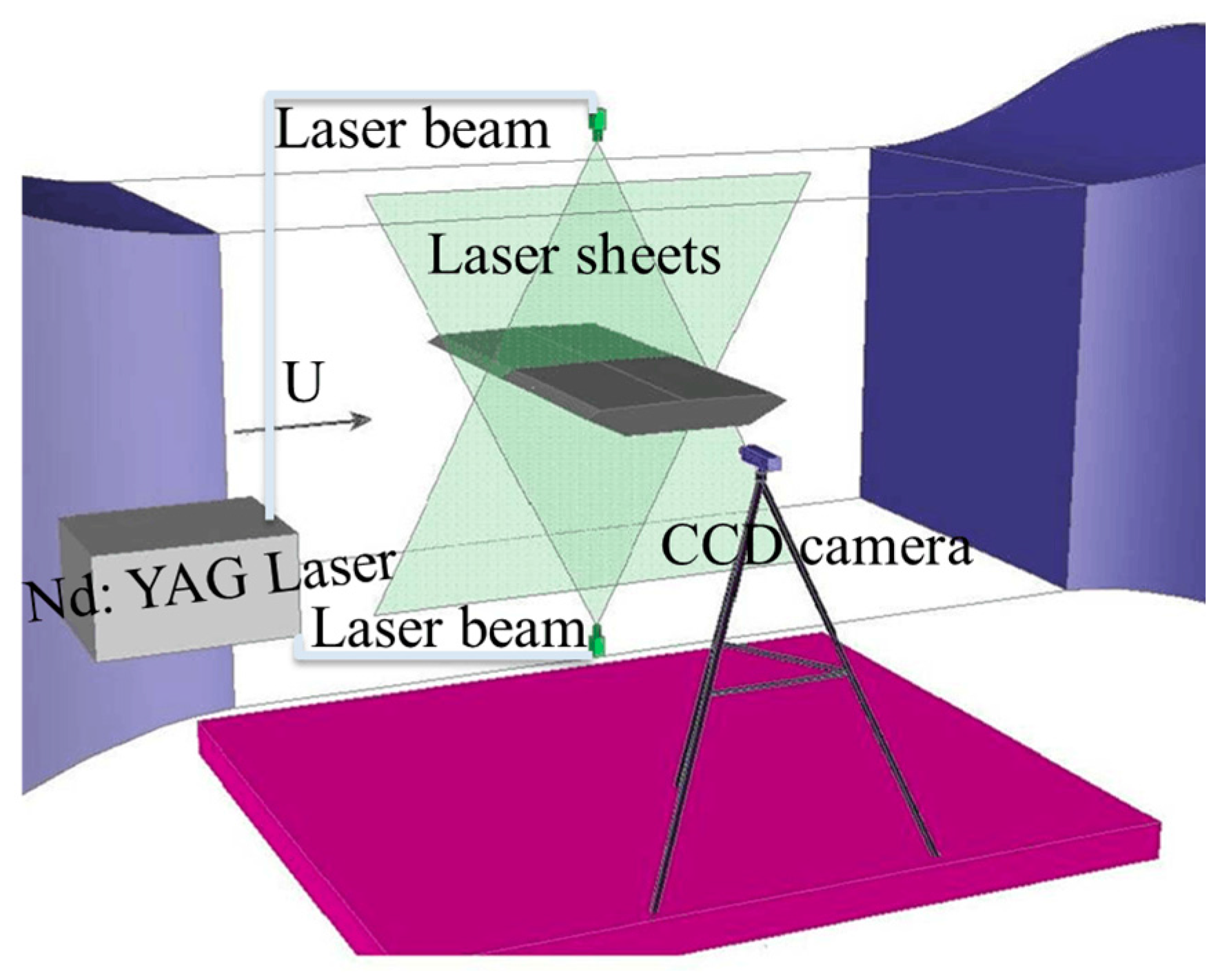
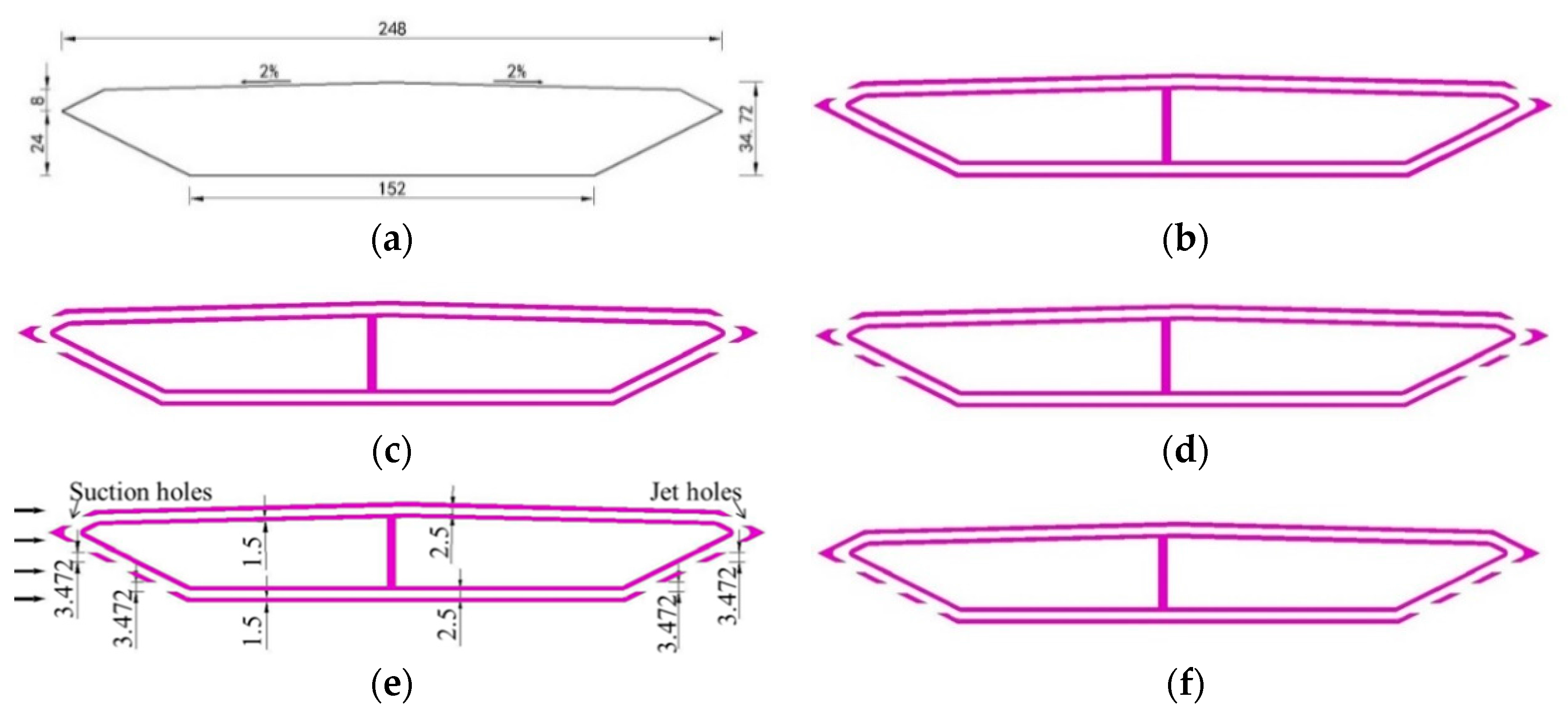
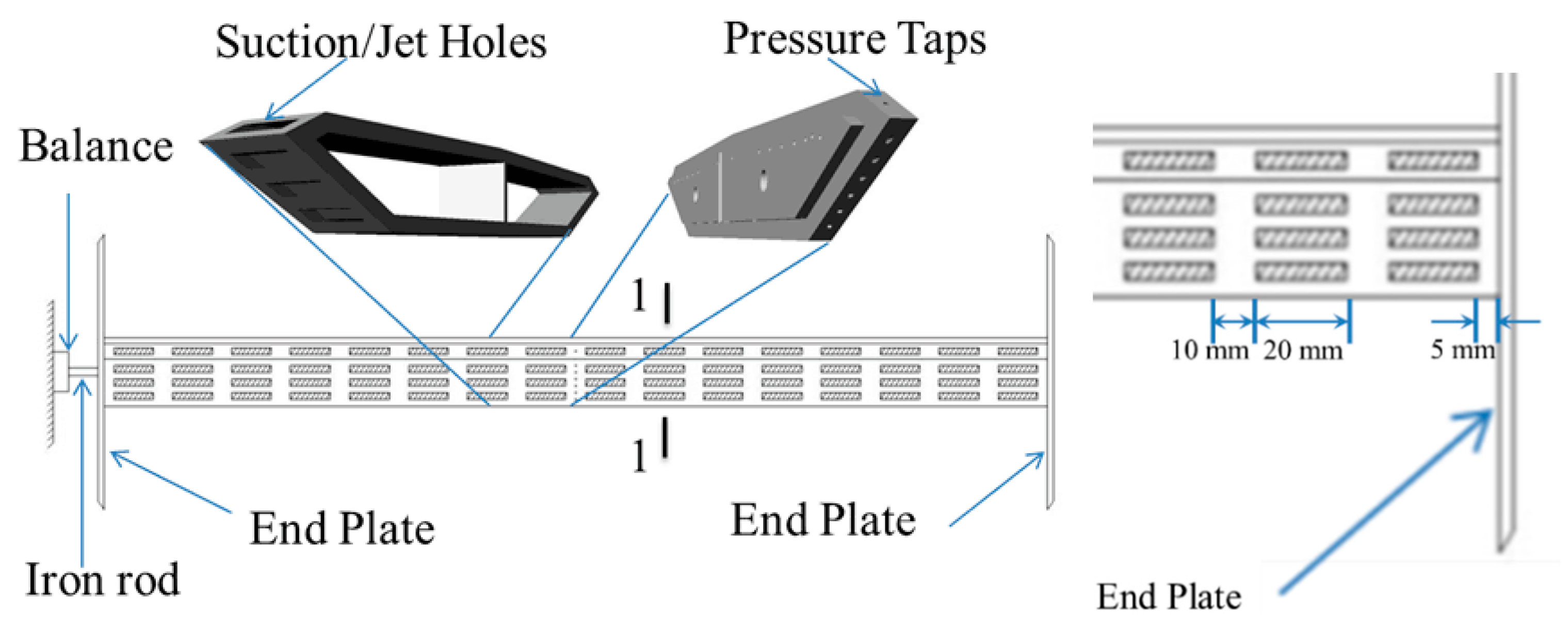

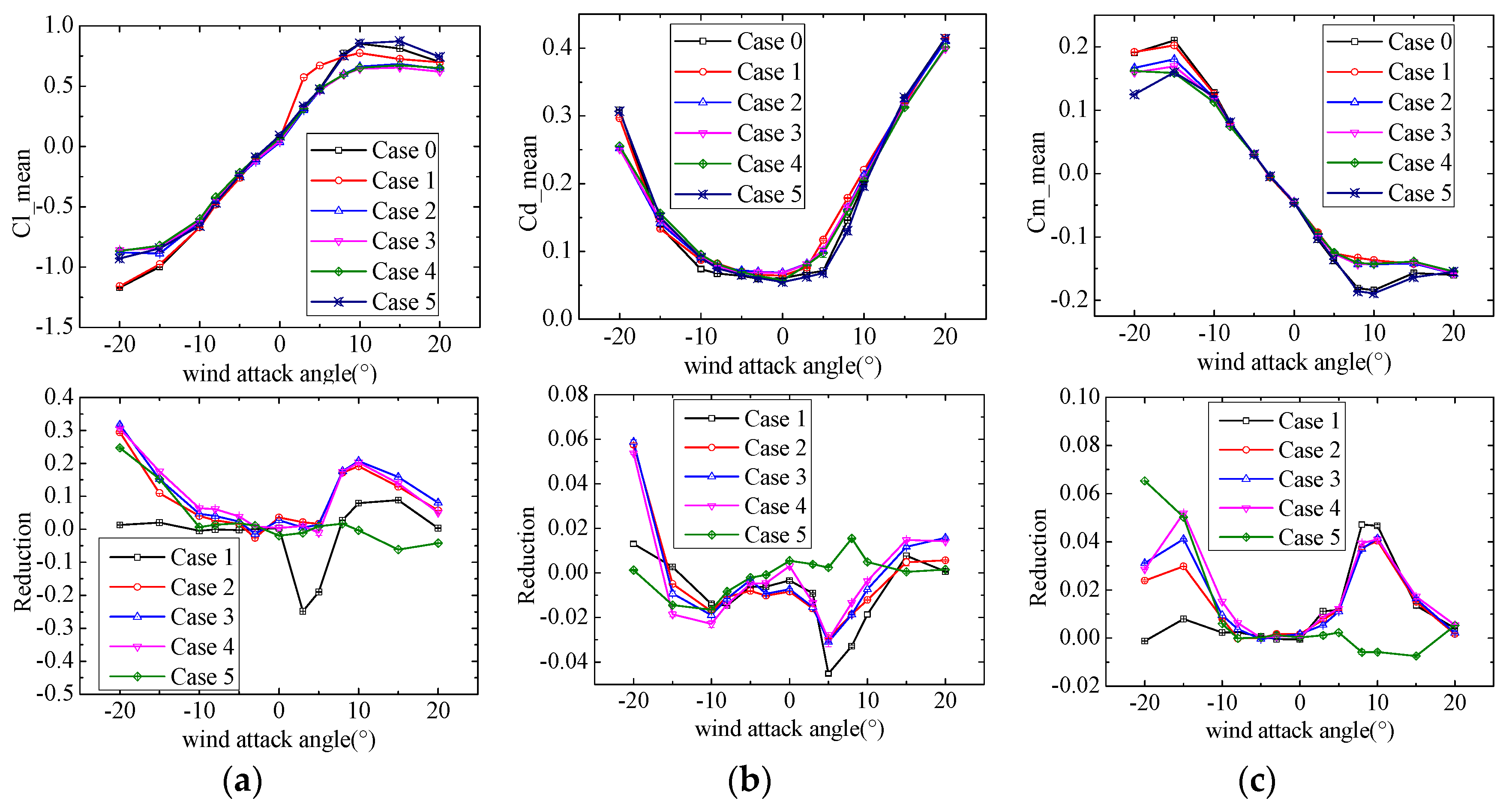

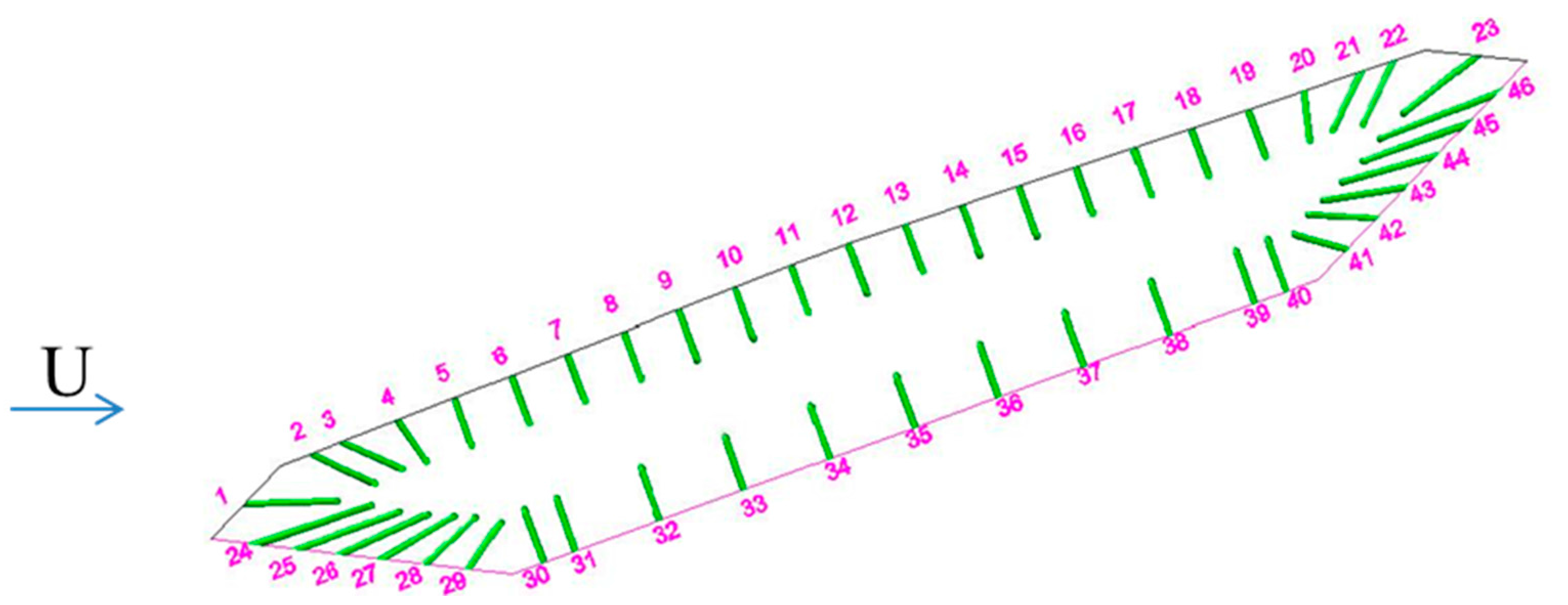

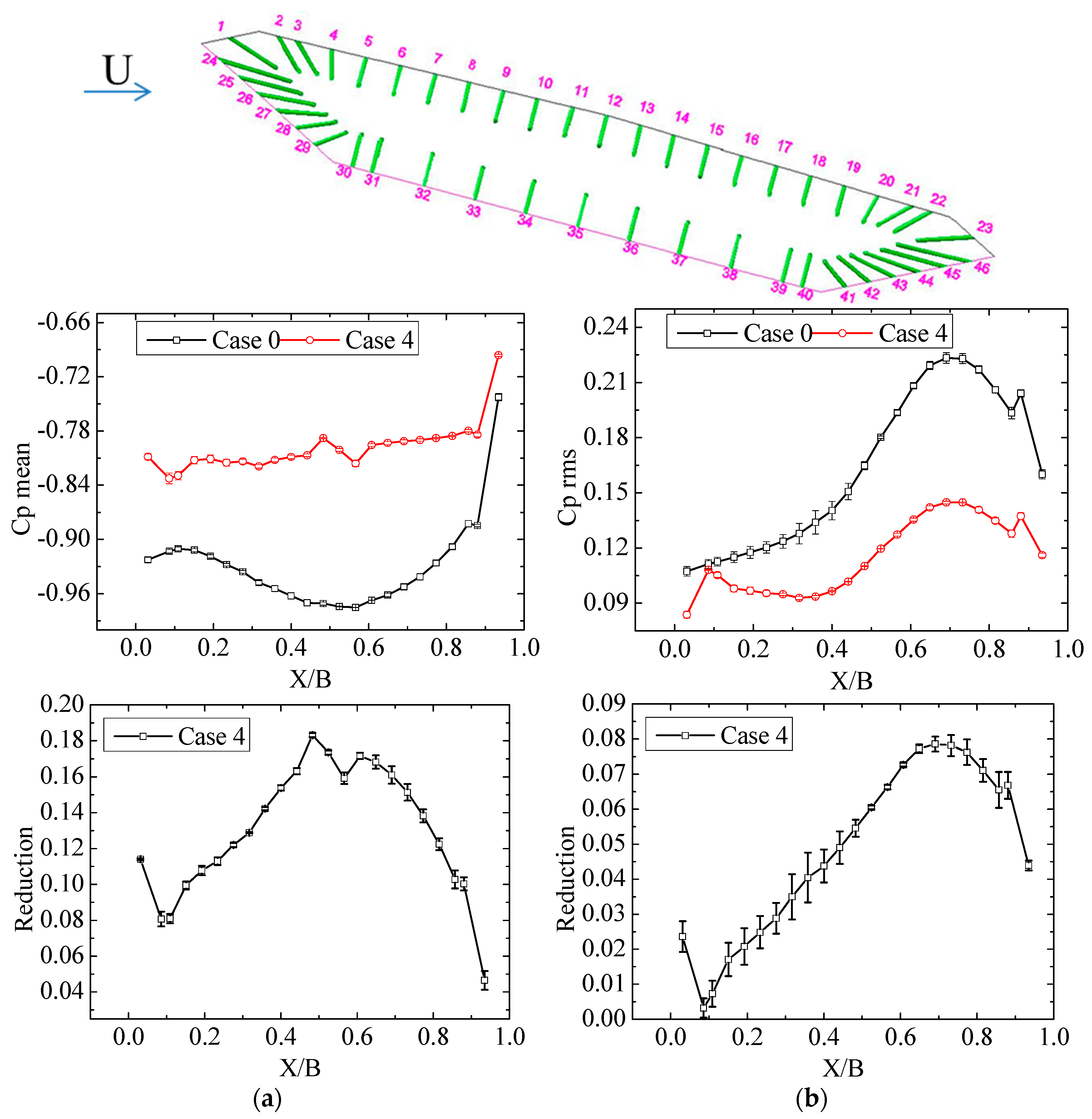

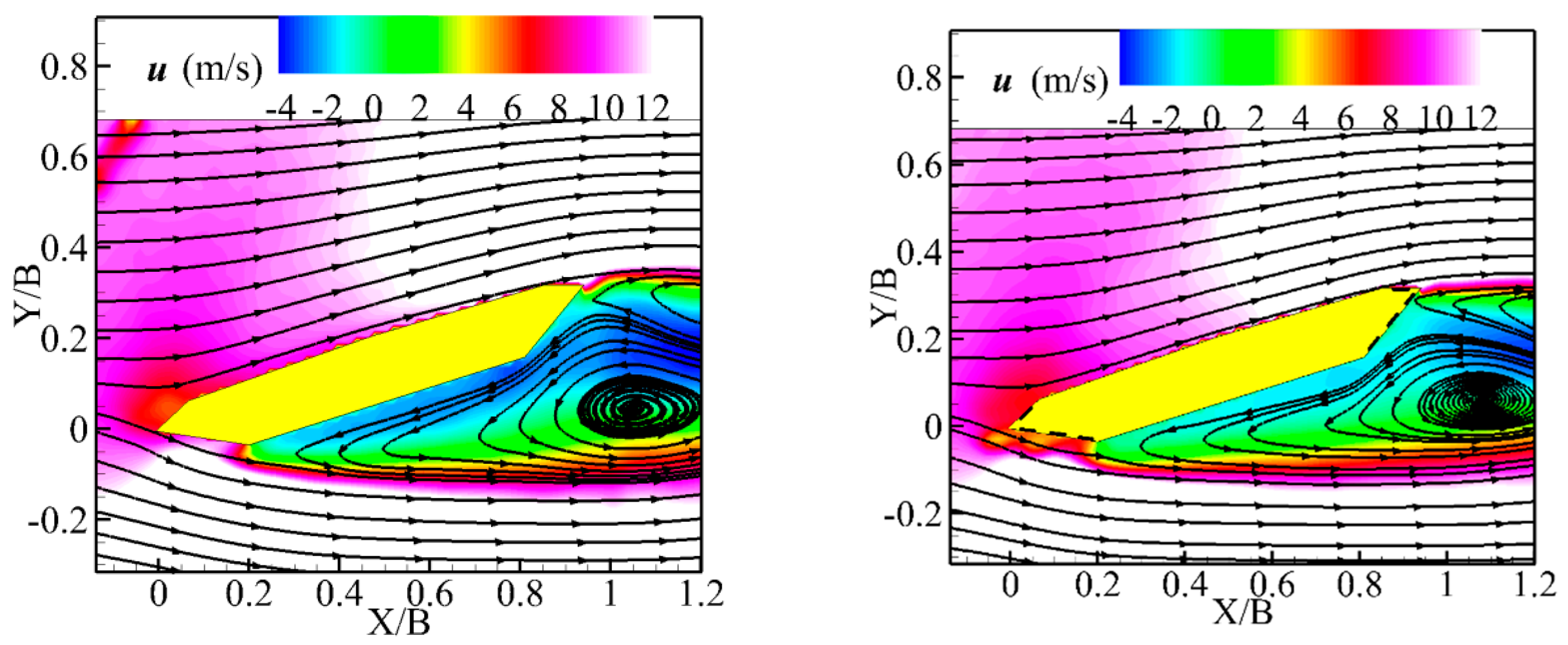
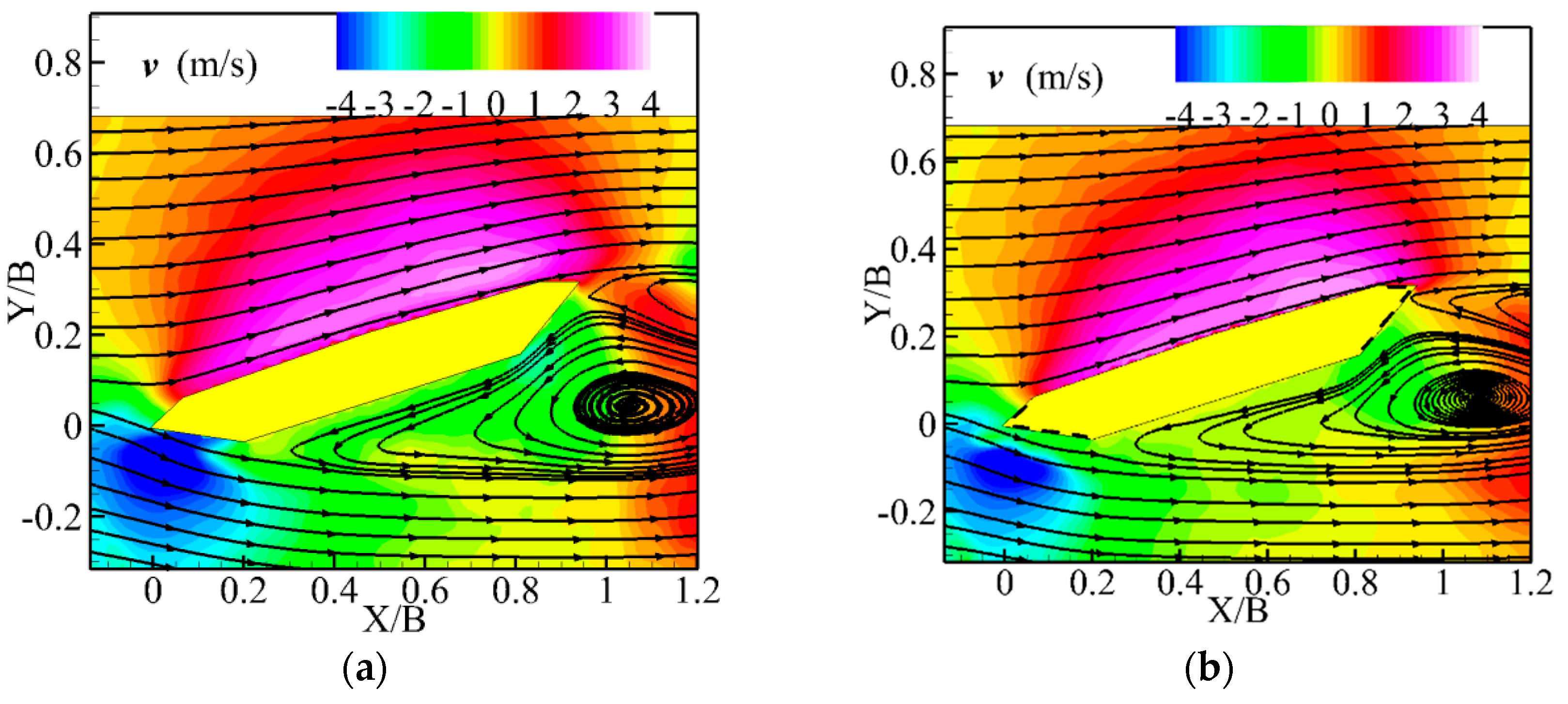
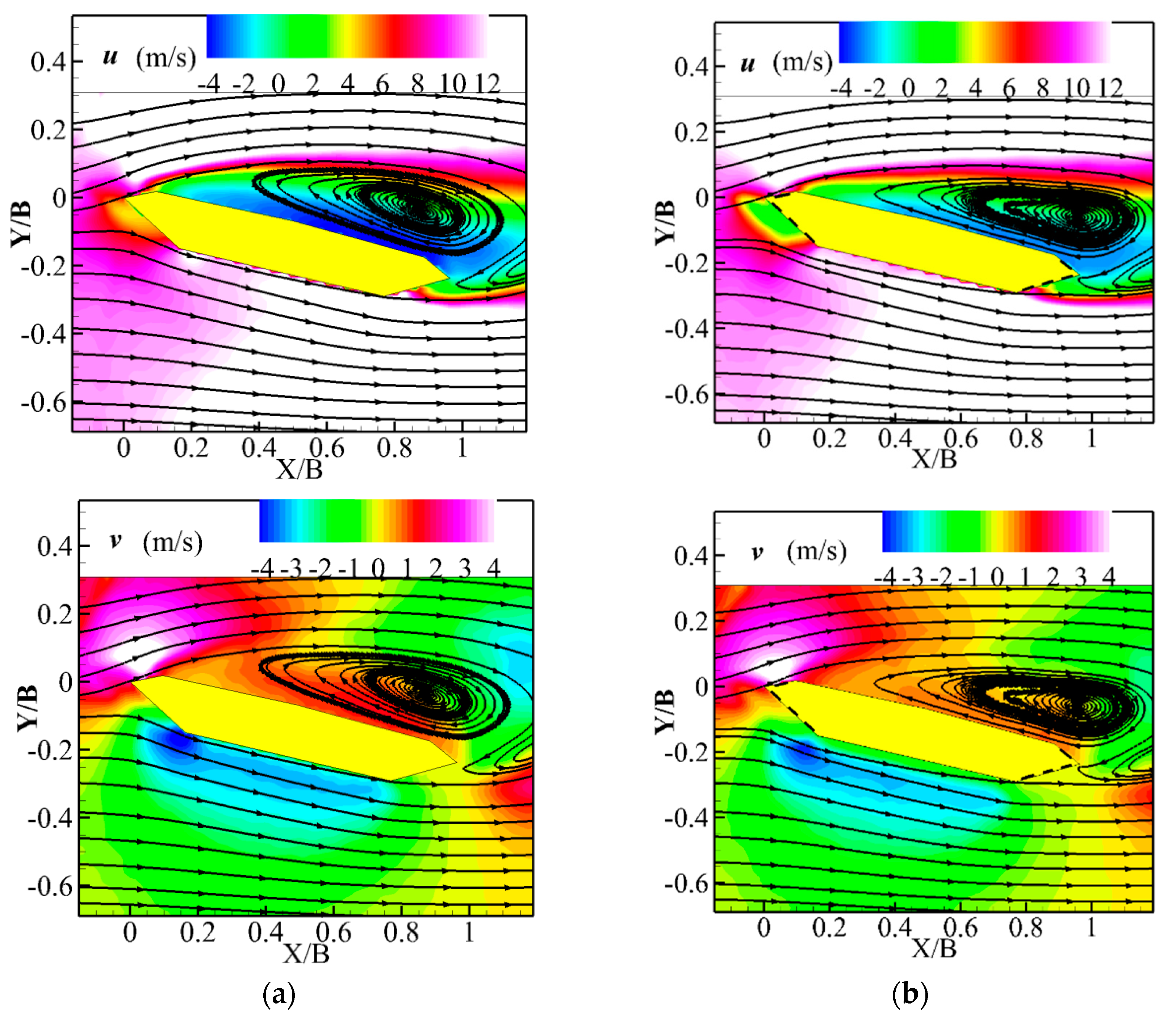

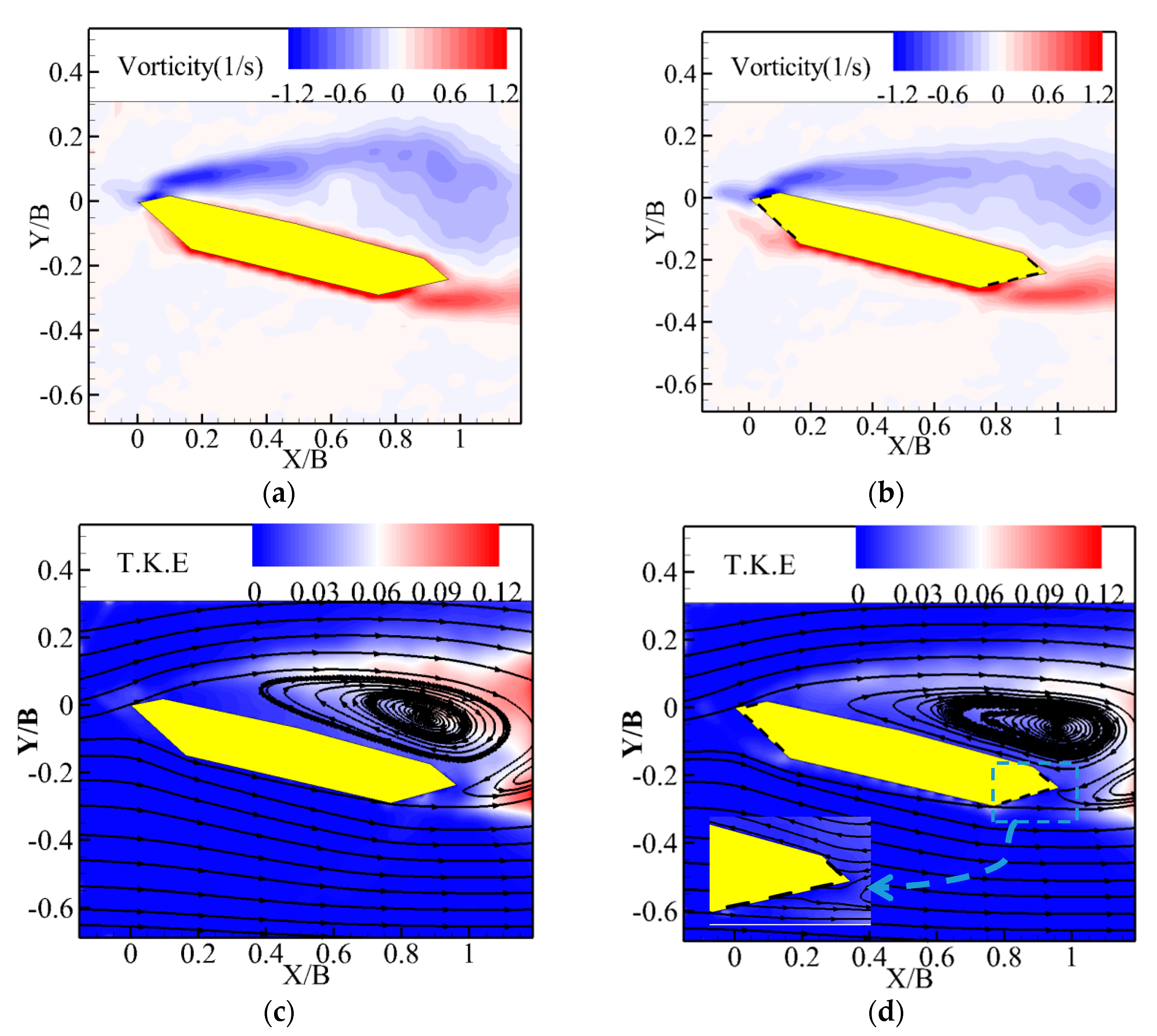
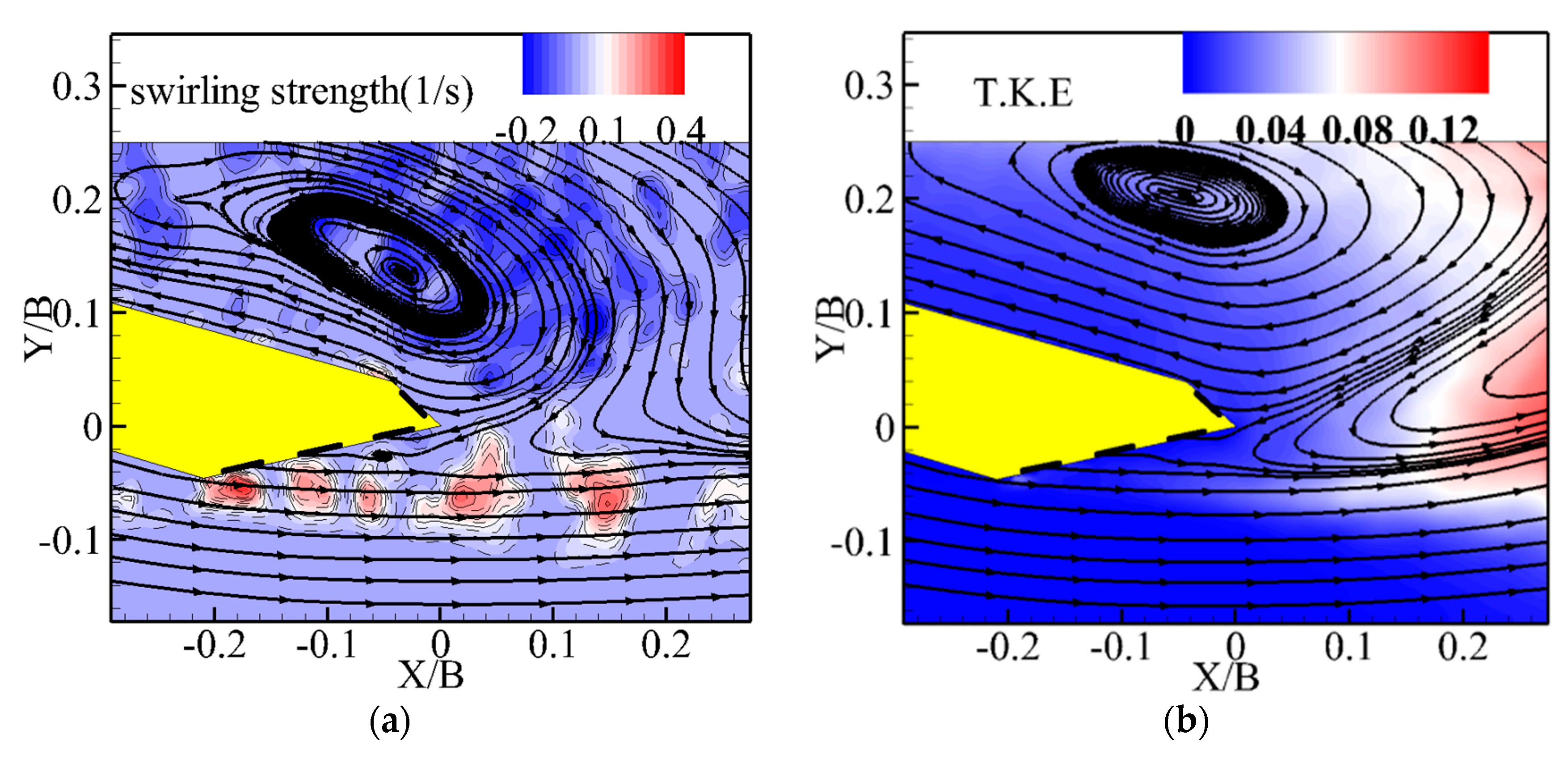


| Control Case | Suction/Jet Holes on US | First Row of Suction/Jet Holes on LS | Second Row of Suction/Jet Holes on LS | Third Row of Suction/Jet Holes on LS | Jsuc |
|---|---|---|---|---|---|
| Case 0 | closed | closed | closed | closed | 0 |
| Case 1 | open | closed | closed | closed | 0.0667 |
| Case 2 | open | open | closed | closed | 0.1333 |
| Case 3 | open | open | open | closed | 0.2000 |
| Case 4 | open | open | open | open | 0.2667 |
| Case 5 | closed | open | open | open | 0.2000 |
| Control Case | Case 0 | Case 1 | Case 2 | Case 3 | Case 4 | Case 5 |
|---|---|---|---|---|---|---|
| Cm_mean * (attack angle) | 5.26 ± 0.017 | 4.80 ± 0.003 | 4.65 ± 0.007 | 4.58 ± 0.006 | 4.48 ± 0.004 | 4.88 ± 0.002 |
© 2017 by the authors. Licensee MDPI, Basel, Switzerland. This article is an open access article distributed under the terms and conditions of the Creative Commons Attribution (CC BY) license (http://creativecommons.org/licenses/by/4.0/).
Share and Cite
Zhang, L.-Q.; Chen, G.-B.; Chen, W.-L.; Gao, D.-L. Separation Control on a Bridge Box Girder Using a Bypass Passive Jet Flow. Appl. Sci. 2017, 7, 501. https://doi.org/10.3390/app7060501
Zhang L-Q, Chen G-B, Chen W-L, Gao D-L. Separation Control on a Bridge Box Girder Using a Bypass Passive Jet Flow. Applied Sciences. 2017; 7(6):501. https://doi.org/10.3390/app7060501
Chicago/Turabian StyleZhang, Liang-Quan, Guan-Bin Chen, Wen-Li Chen, and Dong-Lai Gao. 2017. "Separation Control on a Bridge Box Girder Using a Bypass Passive Jet Flow" Applied Sciences 7, no. 6: 501. https://doi.org/10.3390/app7060501







